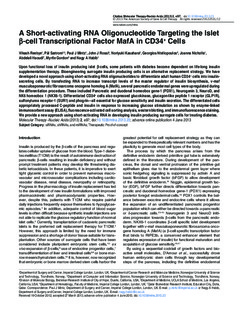| dc.contributor.author | Reebye, Vikash | |
| dc.contributor.author | Sætrom, Pål | |
| dc.contributor.author | Mintz, Paul J | |
| dc.contributor.author | Rossi, JJ | |
| dc.contributor.author | Kasahara, Noriyuki | |
| dc.contributor.author | Nteliopoulos, G | |
| dc.contributor.author | Nicholls, Joanna P | |
| dc.contributor.author | Haoudi, Abdelali | |
| dc.contributor.author | Gordon, Myrtle YA | |
| dc.contributor.author | Habib, Nagy A | |
| dc.date.accessioned | 2019-10-29T13:50:30Z | |
| dc.date.available | 2019-10-29T13:50:30Z | |
| dc.date.created | 2014-01-14T09:15:39Z | |
| dc.date.issued | 2013 | |
| dc.identifier.issn | 2162-2531 | |
| dc.identifier.uri | http://hdl.handle.net/11250/2625194 | |
| dc.description.abstract | Upon functional loss of insulin producing islet β-cells, some patients with diabetes become dependent on life-long insulin supplementation therapy. Bioengineering surrogate insulin producing cells is an alternative replacement strategy. We have developed a novel approach using short-activating RNA oligonucleotides to differentiate adult human CD34+ cells into insulin-secreting cells. By transfecting RNA to increase transcript levels of the master regulator of insulin biosynthesis, v-maf musculoaponeurotic fibrosarcoma oncogene homolog A (MafA), several pancreatic endodermal genes were upregulated during the differentiation procedure. These included Pancreatic and duodenal homeobox gene-1 (PDX1), Neurogenin 3, NeuroD, and NK6 homeobox 1 (NKx6-1). Differentiated CD34+ cells also expressed glucokinase, glucagon-like peptide 1 receptor (GLP1R), sulfonylurea receptor-1 (SUR1) and phogrin—all essential for glucose sensitivity and insulin secretion. The differentiated cells appropriately processed C-peptide and insulin in response to increasing glucose stimulation as shown by enzyme-linked immunosorbent assay (ELISA), fluorescence-activated cell sorting analysis, western blotting, and immunofluorescence staining. We provide a new approach using short-activating RNA in developing insulin producing surrogate cells for treating diabetes. | nb_NO |
| dc.language.iso | eng | nb_NO |
| dc.publisher | Elsevier (Cell Press) for American Society of Gene and Cell Therapy | nb_NO |
| dc.rights | Attribution-NonCommercial-NoDerivatives 4.0 Internasjonal | * |
| dc.rights.uri | http://creativecommons.org/licenses/by-nc-nd/4.0/deed.no | * |
| dc.title | A short-activating RNA oligonucleotide targeting the islet β-cell transcriptional factor MafA in CD34(+) cells | nb_NO |
| dc.type | Journal article | nb_NO |
| dc.type | Peer reviewed | nb_NO |
| dc.description.version | publishedVersion | nb_NO |
| dc.source.volume | 2 | nb_NO |
| dc.source.journal | Molecular Therapy - Nucleic Acids | nb_NO |
| dc.identifier.doi | 10.1038/mtna.2013.23 | |
| dc.identifier.cristin | 1089385 | |
| dc.description.localcode | Molecular Therapy–Nucleic Acids is an open-access journal published by Nature Publishing Group. This work is licensed under a Creative Commons Attribution-NonCommercialNoDerivative Works 3.0 License. To view a copy of this license, visit http://creativecommons.org/licenses/by-nc-nd/3.0/ | nb_NO |
| cristin.unitcode | 194,63,10,0 | |
| cristin.unitcode | 194,65,15,0 | |
| cristin.unitname | Institutt for datateknologi og informatikk | |
| cristin.unitname | Institutt for klinisk og molekylær medisin | |
| cristin.ispublished | true | |
| cristin.fulltext | original | |
| cristin.qualitycode | 1 | |

